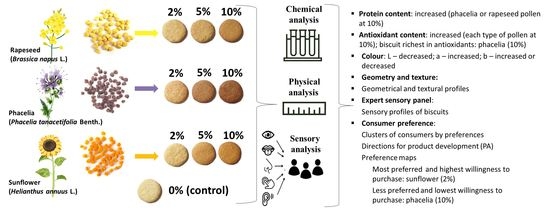Biscuits Enriched with Monofloral Bee Pollens: Nutritional Properties, Techno-Functional Parameters, Sensory Profile, and Consumer Preference
by Rita Végh, Mariann Csóka, Éva Stefanovits-Bányai, Réka Juhász and László Sipos
Foods 2023, Published: 21 December 2022
This article belongs to the Section Nutraceuticals and Functional Foods.
Bee pollens are potential functional food ingredients as they contain essential nutrients and a wide range of bioactive compounds. The aim of this study was to investigate the effects of enrichment with monofloral bee pollens on the nutritional properties, techno-functional parameters, sensory profile, and consumer preference of biscuits. Biscuits were prepared according to the AACC-approved method by substituting wheat flour with pollens of rapeseed (Brassica napus L.), phacelia (Phacelia tanacetifolia Benth.) and sunflower (Helianthus annuus L.) at 2%, 5% and 10% levels. The macronutrient composition of the biscuits was determined: crude protein content (Kjeldahl method), crude fat content (Soxhlet extraction), ash content (carbonization), moisture content (drying), carbohydrate content (formula). Their total phenolic content (TPC) and in vitro antioxidant capacity (FRAP, TEAC, DPPH) were determined spectrophotometrically. The colour of the biscuits was measured using a tristimulus-based instrument, and their texture was characterized by using a texture analyser. Sensory profile of biscuits was determined by qualitative descriptive analysis (QDA). The consumer acceptance and purchase intention of the biscuits were also evaluated, based on the responses of 100 consumers. Additionally, an external preference map was created to illustrate the relationship between consumer preference and the sensory profile of the biscuits, and penalty analysis was conducted to identify directions for product development. Phacelia pollen appeared to be the most effective for improving the nutritional quality of biscuits. The addition of phacelia pollen at the 10% substitution level increased the protein content and TPC of the control biscuit by 21% and 145%, respectively. Significant changes (p < 0.05) were also observed regarding the colour and texture of biscuits. The results of the QDA revealed that biscuits containing pollens of different botanical sources have heterogeneous sensory attributes. The biscuit containing sunflower pollen at the 2% substitution level was preferred the most (overall liking = 6.9 ± 1.6), and purchase intentions were also the highest for this product. Based on the results of the present study, it is recommended to use sunflower pollen for developing pollen-enriched foods in the future.
Keywords: in vitro antioxidant capacity; texture analysis; CIELAB colour space; quantitative descriptive analysis; consumer acceptance; penalty analysis; preference map




